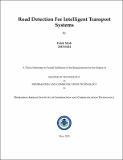Please use this identifier to cite or link to this item:
http://drsr.daiict.ac.in//handle/123456789/555| Title: | Road detection for intelligent transport systems |
| Authors: | Shah, Pratik Dubey, Rahul Shah, Falak |
| Keywords: | Intelligent vehicle Traffic congestion Intelligent transportation systems Company business management Topical scope Manufacturing industries |
| Issue Date: | 2015 |
| Publisher: | Dhirubhai Ambani Institute of Information and Communication Technology |
| Citation: | Shah, Falak (2015). Road detection for intelligent transport systems. Dhirubhai Ambani Institute of Information and Communication Technology, vii, 45 p. (Acc.No: T00518) |
| Abstract: | Road detection is an important machine vision problem with applications to driver assistance systems and autonomous vehicles. We carried out a literature survey of the state of the art road detection algorithms. Simulations of these algorithms were performed on road images taken from multiple datasets which revealed certain limitations such as failure under shadows or in the absence of lane markers. This is why the past few years saw the emergence of illuminant invariant based road detection techniques as the state of the art. As the name suggests, illuminant invariant is a feature which contains the colour information of the surface being captured independent of the illumination source. However, the derivation of illuminant invariant image from the RGB image makes use of the assumption that the surface being captured is lambertian. The smooth road surfaces that reflect sunlight are specular and they violate the lambertian assumption. Thus, the algorithms based on illuminant invariant feature fail to detect the road region containing specularities. The road detection algorithm functions by building a road model in the illuminant invariant feature space for each frame. The white markings that are painted over the roads in the form of zebra crossings, lane markers and arrows are not included into the road model. Hence, the algorithm fails to detect them as a part of road region. The first contribution of this thesis is to address the limitations of specularities and lane markers, thus improving the robustness of the state of the art road detection algorithm. We propose a novel specularity detection and removal method for road scenes which also removes the white markings present in the road image. The region of the image containing specularities/ markers is filled with same shade as its surrounding region. Any road detection algorithm has two aspects- the first is robustness and next is real time implementation. The second contribution of this thesis is implementation of the proposed algorithm on BeagleBone Black and Rapsberry pi-2, which are low cost, low-power single-board computers. This provides a proof-of-concept of real time computation. Thus, the thesis improves the accuracy of the state of the art path detection and provides means of real time implementation on mobile platforms. |
| URI: | http://drsr.daiict.ac.in/handle/123456789/555 |
| Appears in Collections: | M Tech Dissertations |
Files in This Item:
| File | Description | Size | Format | |
|---|---|---|---|---|
| 201311024.pdf Restricted Access | 1.02 MB | Adobe PDF |  View/Open Request a copy |
Items in DSpace are protected by copyright, with all rights reserved, unless otherwise indicated.
